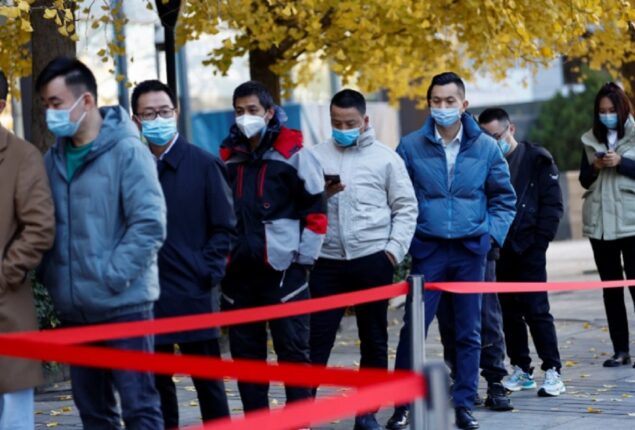Apple iPhone SE 3 price in Pakistan & special features
Apple produced a new 3rd-generation iPhone SE 3 with fair price in...

Chinese iPhone factory riots
China’s COVID-19 cases are soaring, signaling more pain for the world’s second-largest economy as prospects wane for a rapid escape from Beijing’s “zero-COVID” regulations.
National Health Commission reported 29,157 illnesses for Tuesday, around April’s peak.
China’s daily caseload peaked at 29,411 on April 13 during Shanghai’s severe lockdown, which caused food shortages and civil turmoil.
A video circulating on social media Wednesday seemed to depict worker dissatisfaction at Apple supplier Foxconn’s Zhengzhou factory.
In videos published on Kuaishou, individuals smashed surveillance cameras and windows, pulled down obstacles, and chanted for money.
Former Foxconn employees have complained of food shortages and stringent quarantine measures at the iPhone factory’s campus. Two sources verified protests at the Zhengzhou factory to Reuters but declined to disclose details.
Moreover, half of Wednesday’s cases, including 26,400 asymptomatic infections, were reported in Guangzhou and Chongqing, megacities with more than 35 million inhabitants.
In Beijing, where schools have been closed, testing standards have been strengthened, illnesses hit 1,486.
Shanghai and Zhengzhou, both with lesser outbreaks, saw their cases climb.
Guangzhou launched a five-day lockdown on Monday after similar measures earlier this month sparked rare demonstrations. Chengdu began a new round of widespread testing on Wednesday.
The limits are a new blow to China’s stuttering economic recovery and dampen hopes for a shift away from “zero COVID” after efforts to lift curbs and revitalize the faltering real estate sector momentarily boosted Wall Street.
“I think [the excitement] will be short-lived because of the market. The October data was bad, but they couldn’t ignore the economic plans, Natixis’ top Asia-Pacific economist told.
November will be awful because the opening hasn’t happened.
China’s GDP may only grow 3% in 2022, one of its poorest showings in decades. GDP climbed 3.9% in July-September after growing 0.4% in the second quarter.
Mobility has remained low in all of China’s main cities except Shanghai, driving down consumer spending and investment, said Garcia-Herrero. Exports fell 0.3% year-over-year in October, the first time since June 2020, due to COVID-19 restrictions and weak demand outside China, according to Natixis.
China’s economic recovery requires more mobility, but relaxing restrictions will increase mortality, especially among the elderly, said Garcia-Herrero.
Only 66% of adults 80 and older are vaccinated, and 40% have received a booster injection.
Sinovac, China’s indigenous vaccine, is less successful at preventing serious sickness than mRNA vaccines.
Exiting “zero COVID” won’t address China’s economic troubles overnight, said Carsten Holz, an economist at Hong Kong University of Science and Technology. He called the approach a “double blow for the economy.”
Holz told Al Jazeera that COVID-19 limits hinder output, disrupt supply chains, and hurt retail sales. When COVID limitations are loosened, the economy adjusts, causing disruptions and instability. Some foreign demand may have also departed the PRC.”
According to experts, China’s third-quarter economic comeback doesn’t bode well for the rest of the year.
Much of the country’s recent growth has been driven by the state sector, not private consumption, says Nick Marro, the lead global trade analyst at the EIU.
Confidence among foreign and private enterprises on the ground remains “shattered” due to “zero COVID.”
Marro told Al Jazeera that the economy is growing unbalanced. “Over the last two years, a lot of growth has come from investments and exports, not private consumption, because ‘zero COVID’ has destroyed retail activity and private consumption.”
Alibaba, whose revenue growth has flatlined in recent months, did not publish sales data for its November 11 “single’s day” shopping holiday, which generated $84.5bn in 2021.
Foxconn has had trouble producing the iPhone 14 Pro and Pro Max at its Zhengzhou production after a rise in illnesses prompted the company to close earlier this month.
Marro said the factory closure illustrated the limits of “zero COVID,” even as corporations tried to diversify manufacturing sites, and how far Beijing must go to convince people to live with the virus.
“We noticed an exodus of students leaving Zhengzhou, and there was some discussion that dorm conditions were so awful because of ‘zero COVID,’ but it also felt like people were fleeing because they were frightened of acquiring the virus,” he said.
“That demonstrates the government hasn’t done anything to make COVID less terrifying. Even if the government lifts COVID zero protocols, the populace may be resistant to accepting it and cohabit with the virus.
Catch all the Sci-Tech News, Breaking News Event and Latest News Updates on The BOL News
Download The BOL News App to get the Daily News Update & Follow us on Google News.